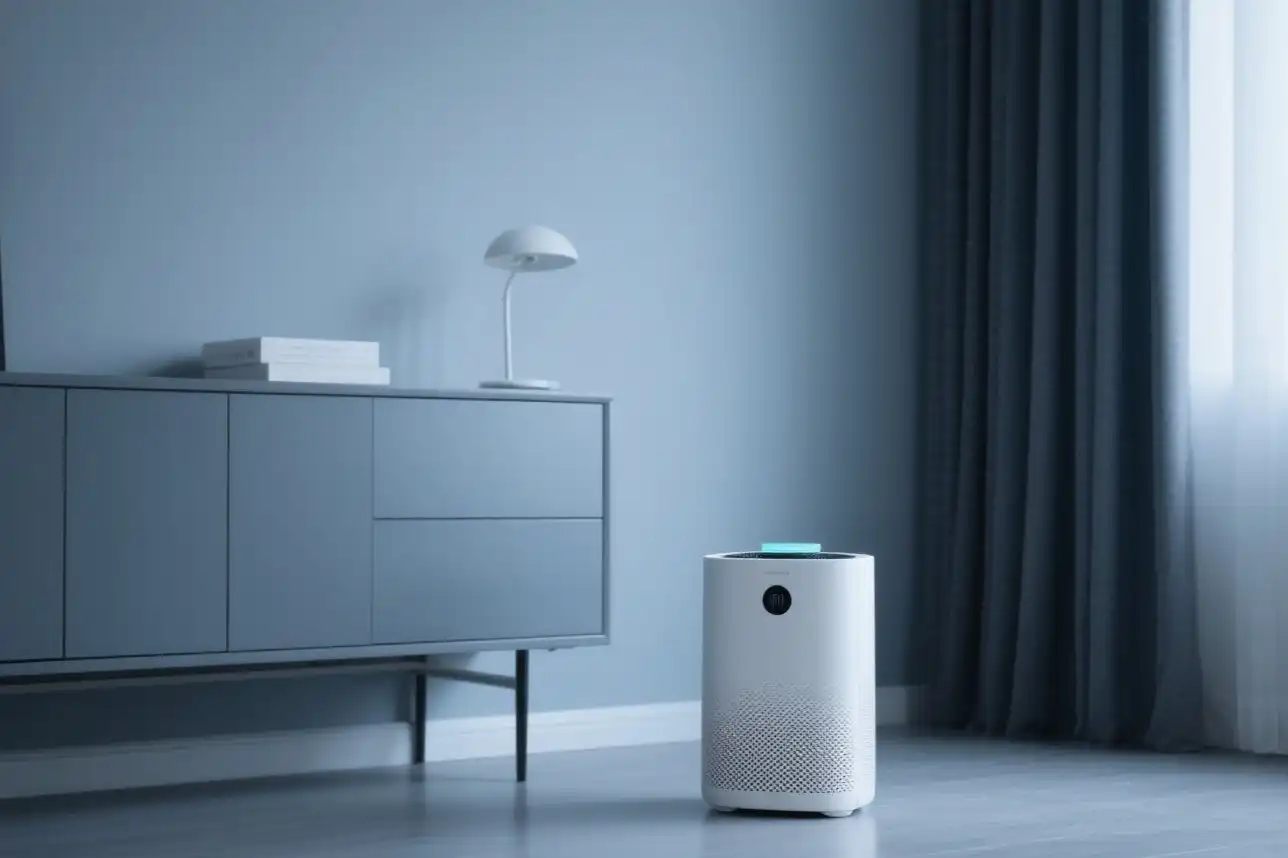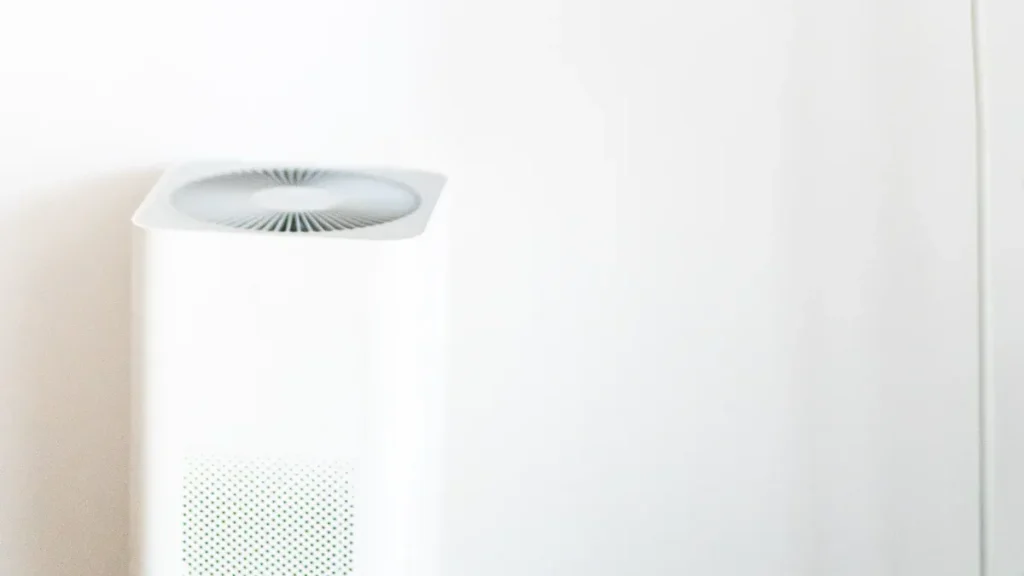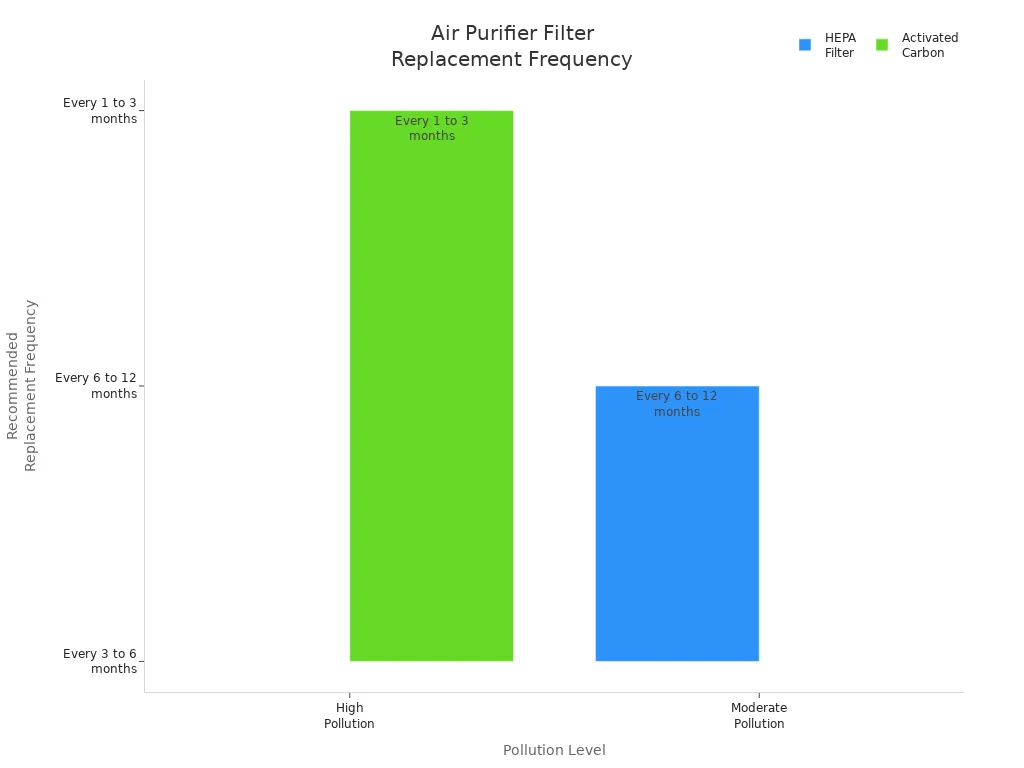
If you want to know how many air purifiers you need, use the “2/3 Rule.”
- Choose an air purifier with a Clean Air Delivery Rate (CADR) that is at least two-thirds of your room’s square footage. For example, a 300 sq ft room needs a CADR of at least 200 CFM.
- If your ceiling is taller than 8 feet, increase the CADR to match the extra height.
- Matching the right CADR to your space helps you get enough air changes per hour, which keeps your air clean.
Key Takeaways
- Use the 2/3 Rule. Pick an air purifier with a CADR that is at least two-thirds of your room’s size. This helps make sure you get enough clean air.
- One good air purifier is enough for small and medium rooms. Big rooms or rooms with high ceilings may need two units to work well.
- Do not put air purifiers in corners or behind furniture. Put them near where pollution comes from or in the middle of the room. Leave space around them so air can move easily.
- Measure your room and ceiling height to find the right CADR. Try to get 4-5 air changes every hour for healthy air.
- Take care of your air purifier by changing filters often. Use more than one unit if you have many rooms or lots of pollution in your home.
Air Purifier Guidelines
Choosing the right air purifier for your space depends on the size of the room and how the air moves within it. Manufacturers group rooms into categories based on square footage. Matching your room to these categories helps you select the best air purifier for clean, healthy air.
| Room Size Category | Approximate Coverage (sq ft) | Example Air Purifier Models |
|---|---|---|
| Small | ~275 sq ft | TrueCarbon™ 150C |
| Medium | 375 – 780 sq ft | TrueCarbon™ 200C, AirMend™ 200HB |
| Large | 475 – 888 sq ft | TrueCarbon™ 270C, AirMend™ 270HB, Mod Jr. |
| Extra Large | Up to 1361 sq ft | Mod+ |
Small Rooms
Small rooms usually measure up to 275 square feet. Bedrooms, nurseries, and home offices often fall into this category. For these spaces, you need only one air purifier if you choose a model with a Clean Air Delivery Rate (CADR) that matches your room size.
Tip: One air purifier with a CADR of 200-400 CFM can clean a small room under 150 sq ft at the recommended 4-5 air changes per hour (ACH). This means you do not need multiple units for most small rooms.
Testing shows that a single 250 CFM unit works better than two smaller units in a small room. You get better energy efficiency, less noise, and stronger air cleaning. The Levoit Core 300 is a good example of a model that fits these needs.
| CADR (CFM) | Coverage at 2 ACH (sq ft) | Coverage at 4 ACH (sq ft) |
|---|---|---|
| 200 | 750 | 375 |
| 250 | 938 | 469 |
| 300 | 1125 | 563 |
| 400 | 1500 | 750 |
Medium Rooms
Medium rooms range from 375 to 780 square feet. Living rooms, larger bedrooms, and playrooms often fit here. For these spaces, one air purifier with a higher CADR (around 250-350 CFM) usually works well. Make sure the unit can provide at least 4-5 ACH for the best results.
If your medium room has high ceilings or an odd shape, you may need a more powerful air purifier or even two units. Place them on opposite sides of the room for even coverage.
Large Rooms
Large rooms cover 475 to 888 square feet. Family rooms, basements, and open-plan living areas often fall into this group. For rooms up to 635 sq ft, a single high-capacity air purifier, such as the Levoit Core 600S (CADR 410 CFM), can provide enough clean air. This model achieves about 4.8 ACH, which meets health guidelines.
For rooms larger than 635 sq ft, you should use two air purifiers. Placing two units in different parts of the room helps maintain good air quality throughout the space. This approach also gives you backup if one unit needs maintenance.
Open Spaces
Open spaces, such as open floor plans or lofts, allow air to move freely. In these areas, a single high-capacity air purifier can often cover the whole space. However, you must check the total square footage and ceiling height. If the area is very large or has high ceilings, you may need more than one unit.
- Open floor plans let you use fewer air purifiers because air flows easily.
- Enclosed rooms with doors and walls need separate units for each space.
- Multi-story homes work best with one air purifier per floor.
- Place units away from corners and obstructions for the best airflow.
Note: If your home has many separate rooms or floors, you will need more air purifiers to keep the air clean everywhere.
When Do You Need More Than One Air Purifier?
You may need more than one air purifier if:
- The room is very large or has high ceilings (over 8 feet).
- The space has poor air circulation or many obstacles.
- You have multiple separate rooms or floors.
- You want to target specific areas with high pollution, such as kitchens or pet rooms.
Always match the CADR of your air purifier to the size and volume of your space. Focus on rooms where you spend the most time, like bedrooms and living rooms. Avoid placing units in corners or behind furniture to maximize their effectiveness.
Calculation Steps
Measure Room Size
Start by measuring your room’s length and width in feet. Multiply these numbers to get the square footage. For example, a room that is 12 feet by 10 feet has 120 square feet. This step is important because the size of your room tells you how powerful your air purifier needs to be.
Tip: Always measure the main area where you want clean air. If your room has an odd shape, break it into smaller rectangles, measure each, and add them together.
Check CADR and ACH
Next, look at the Clean Air Delivery Rate (CADR) on the air purifier’s label. CADR shows how much clean air the device can deliver, measured in cubic feet per minute (CFM). You want a CADR that matches your room size. Use the formula:
Required CADR (CFM) = (Room Area × Ceiling Height × Desired ACH) ÷ 60
ACH stands for Air Changes per Hour. It tells you how many times the air in your room gets cleaned each hour. For most homes, aim for 4 to 5 ACH. If you have allergies or pets, choose a higher ACH.
| Room Use | Recommended ACH |
|---|---|
| General Living | 3-4 |
| Allergies/Pets | 5-6 |
| High Pollution | 6+ |
Ceiling Height
Ceiling height changes how much air needs cleaning. Most CADR ratings use an 8-foot ceiling. If your ceiling is higher, you have more air volume. For a 10-foot ceiling, increase your CADR by about 25%. This adjustment helps your air purifier keep up with the extra space.
Note: Rooms with high ceilings may need a stronger fan or a second unit for best results.
Room Layout
Room layout affects how well your air purifier works. Furniture, walls, and partitions can block airflow. If your room has many obstacles or separate areas, you may need more than one unit. Place your air purifier in an open spot, away from corners and large furniture, to help air move freely.
- Sealed partitions can keep air from moving between spaces.
- Furniture can create dead zones where air does not circulate well.
- Open layouts allow one purifier to cover more space, but closed rooms may need separate units.
Special Cases
Air Quality Needs
If you have allergies or asthma, you may need extra help. Some air purifiers have features that make breathing easier.
- HEPA filters can trap almost all tiny particles, which helps with allergies.
- Filters made for asthma and allergies can catch most allergen particles.
- Stay away from ionizing purifiers that make ozone, because ozone can bother your lungs.
- Pick a purifier with the right clean air delivery rate for your room.
- Air purifiers cannot get rid of gases like VOCs or smoke gases.
- Cleaning, keeping humidity under 50%, and taking care of pets or pests also help air quality.
Studies show air purifiers work best when you use them with other ways to keep indoor air clean.
Multi-Room Homes
If your home has many rooms, you need to keep air clean in each one. You can use more than one air purifier to cover all your rooms.
| Strategy Aspect | Recommendation |
|---|---|
| Number of Units | Use one unit for every 300-500 sq ft; add more if you have many rooms. |
| Placement | Put purifiers in bedrooms, living rooms, and offices for the best results. |
| Multiple Small Units vs One | Using several small units gives better coverage and saves energy. |
| Airflow and Clearance | Leave 3-5 feet of space around each unit for good airflow. |
| Door Positioning | Keep doors a little open to help air move between rooms. |
Measure each room and match the purifier’s CADR to the room size. Put purifiers near things that make pollution, like kitchens or carpets, for the best results.
High Pollution
If there is a lot of outdoor pollution or wildfire smoke, indoor air can get worse. You may need to do more to keep your air safe.
- Using more than one purifier or filter unit lowers indoor PM2.5 better, especially in rooms with lots of air movement.
- Cheap options, like MERV-13 filters on box fans, can work well and save money.
- Rooms with more fresh air coming in need more filter units to keep pollution low.
When there is smoke outside, you may need to run a few units at the same time to keep your indoor air safe.
Placement Tips

Best Locations
You can make your air purifier work better by putting it in the right spot. Try to place it in the middle of the room or close to things like kitchens, pet beds, or doors. Do not put it in corners, on thick rugs, or behind big furniture. These places block the air and make the purifier clean less air, sometimes by half. Leave at least 3-5 feet of open space around your air purifier. In bedrooms, keep it 6-10 feet from your bed so it is not too loud but still cleans well. If you have a small air purifier, put it about 3 feet off the ground to catch more dust. Always set it on something flat and steady. Do not put it near electronics or things that get hot.
| Position | Particle Removal Efficiency | Notes |
|---|---|---|
| Center of room | High | Best for even coverage |
| Near pollution sources | High | Reduces pollutants before they spread |
| Against wall (intake facing room) | Moderate to High | Good if space is limited |
| Corners or behind furniture | Low | Avoid due to blocked airflow |
Maximizing Efficiency
You can help your air purifier work its best by doing a few easy things: Keep at least 12-15 inches between the purifier and any wall or object. Make sure the side that pulls in air faces the main part of the room or the place with the most pollution. Do not let the air blow right on people, so everyone stays comfortable. Use the right filter for what you need, like HEPA for allergies or carbon for smells. If your room is big or open, use more than one air purifier to clean all the air.
Tip: If people walk around a lot in the room, put the air purifier where people walk the most. This helps it catch dust and allergens faster.
Maintenance
Taking care of your air purifier helps it last longer. Change the filters when the company says to. HEPA filters last 6-12 months, but if the air is dirty, change them every 3-6 months. Carbon filters should be changed every 3-6 months. Clean the pre-filter every few months. Wipe the outside to get rid of dust. Always look for filter lights or check the filters to see if they need changing.

Note: Keep doors and windows shut when your air purifier is on. This keeps the clean air inside.
To find out how many purifiers you need, follow these steps:
- Decide how many air changes per hour you want for your space.
- Check if your HVAC system already helps with air cleaning.
- Calculate the extra cleaning needed and choose purifiers with the right clean air delivery rate.
- Place units where air moves best and keep up with filter changes.
Matching purifier size and placement to your room helps you avoid common mistakes and keeps your air healthy.
FAQ
What is the best way to choose an air purifier for my room size?
You should check your room’s square footage. Match it to the air purifier’s CADR rating. Use the 2/3 Rule: CADR should be at least two-thirds of your room size in square feet.
What happens if I use an air purifier that is too small for my room?
A small air purifier cannot clean all the air in a large room. You may not get enough air changes per hour. This means dust, pollen, and other particles can stay in the air.
What does CADR mean and why does it matter?
CADR stands for Clean Air Delivery Rate. It shows how much clean air the purifier can make each minute. A higher CADR means the purifier can clean your room faster and more effectively.
What should I do if my room has high ceilings?
You should increase the CADR rating by about 25% for ceilings higher than 8 feet. This helps the air purifier clean the extra air volume in your room.
What rooms need air purifiers the most?
Bedrooms, living rooms, and spaces with pets or smokers need air purifiers the most.
You spend a lot of time in these rooms, so clean air helps you stay healthy.
The following information may be of interest to you
How Air Purifiers Maintain Clean Air in Modern Homes
What Air Purifiers Can Do to Remove Mold from Your Home
Whether one air purifier can be suitable for multiple rooms
What to Consider Before Putting an Air Purifier in Every Room
